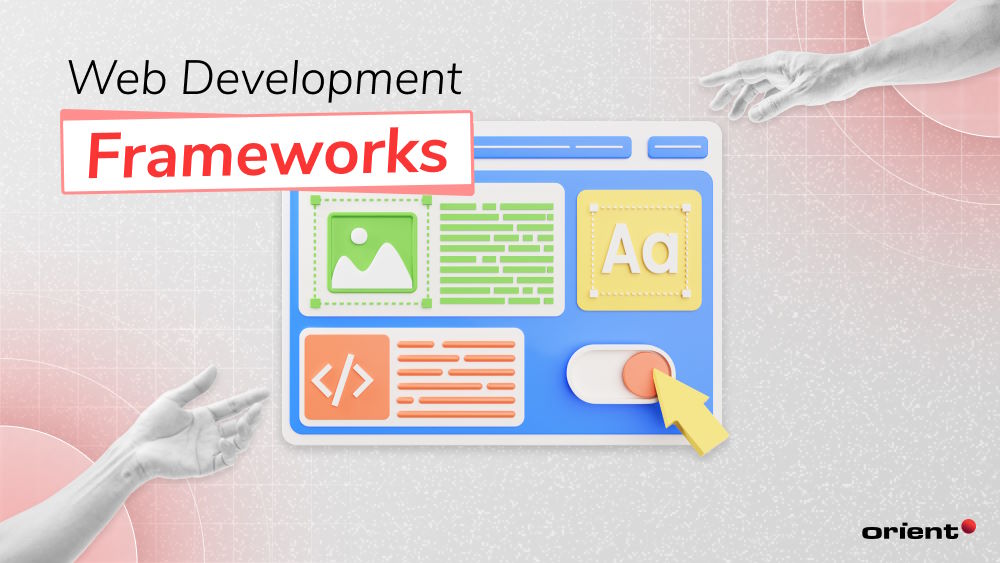Top Ten Web Development Frameworks All Developers Should Know

Content Map
More chaptersMore than ever before, building a digital presence is no longer a luxury yet a necessity for every organization or even individual. As for the business realm, it plays an even greater part in building brand images, boosting customer awareness, and driving prospects. Typically, you have witnessed retailers worldwide shifting from brick-and-mortar stores to online shops to survive in this ever-changing market.
And websites, or now web apps in the current digital world, have become the lifeblood of that online presence. Hence, it soon has become a common standard for businesses to create their own websites. From young start-ups to senior companies or large enterprises across industries, all perceive that web development must be included in their business journey toward success.
Obviously, developing normal web pages or modern web applications is no joke. The whole development process of a website from scratch requires deep expertise and skills in this field. That is why many developers and webmasters turn to the help of web development frameworks.
What Is a Web Development Framework?
What is a web framework, you may ask? It is a combined pack that provides web developers with pre-written components, code snippets, application templates, tools, and libraries utilized to build web resources, such as web services and web application programming interfaces (Web APIs), and accelerates the entire development process.
Web development frameworks provide somewhat of a web app skeleton. From there, web developers can leverage the available component-based architecture for building web applications with much lesser effort and time instead of coding from the ground up. With a flexible framework, engineers can add code to customize the given structures for developing web applications at their disposal.
A web developer with a proper framework can rapidly develop a web app or website with fewer concerns about minor details, such as security issues and code rewriting. In addition to boosting developer productivity, web development frameworks also facilitate the delivery of robust, reliable, and secure websites.
The Ten Best Web Development Frameworks
At current, the number of software development frameworks of different categories is vast, and they are designed for different programming languages and for various purposes. Each one proves to be handy case by case and project by project. There can be many web development frameworks, which are divided into two main categories: Frontend and backend web development. Both are two crucial parts of all dynamic web applications.
The following are the most popular web frameworks of each type. Bear in mind that the right web development framework can only be decided based on your project goals and requirements. So, be selective and cautious before making a choice.
Front-end Web Frameworks

Front-end or client-side frameworks are web development tools used to design and create visually appealing user interfaces for a website solution. These front-end frameworks enable developers to avoid ‘reinventing the wheel’ when coding, as they provide a set of conventions for how to structure the application, connect to databases, implement user interfaces, manage state, handle routing, and other everyday tasks.
Angular
Developed and maintained by Google, Angular is a JavaScript framework based and written in TypeScript, which is a superset for developing web apps, particularly single-page applications (SPAs). It provides easy two-way data binding, automatic Document Object Model (DOM) updates, and an extensive library of components, making it a reliable framework for building enterprise-level web apps. Renowned companies using Angular to empower their websites are Upwork, PayPal, Lego, etc.
React
Not actually a framework, it is an open-source JavaScript library maintained by Facebook and Instagram, along with a large community. React boasts of creating fast apps and websites due to its virtual DOM system, which works independently from the real DOM in the browser window without reloading it every time an update occurs. React is perfect for creating large web apps with continuously changing data over time.
Vue.js
Vue.js is one of the most trending front-end frameworks. It is an open-source progressive JavaScript framework. Vue.js is lightweight, versatile, and modern, which enables you to integrate it with other libraries or existing projects. Vue.js is most famous for its fast performance and flexible structure that can handle nearly any web development project without a hassle. It has an easy learning curve, so novice engineers also find it user-friendly and straightforward. Companies such as Adobe, Xiaomi, and Alibaba are among those who have employed Vue.js to upgrade their websites.
Ember
Ember is an open-source web framework written in TypeScript and JavaScript. It is based on the Model-View-View-Model (MVVM) architecture pattern, designed to build ambitious web applications with rich user experiences. Ember is well-known as the best web development framework, providing robust features and a wide range of add-ons that can be used to expand its capabilities. Also, it supports desktop and mobile apps. There is a large community behind the Ember framework, so new features are updated frequently. Apple Music is a prime example of a web app built with Ember.
Backbone
Backbone is an extremely light client-side framework. It helps you to structure your code according to the Model-View-Presenter (MVP) architecture template, which makes the app more manageable and organized. Backbone allows the development of single-page apps quickly and comes with lots of features such as event triggering, templating, Models, Views, RESTful APIs, and collections. Companies such as Bitbucket, Yammer, and Airbnb have used Backbone to power their web projects.
Back-end Web Frameworks

Server-side or backend frameworks are used to build the back part of the logic of web applications, such as data communication, user authentication, authorization, and security protocols. These backend development tools provide many built-in libraries and components that allow developers to write code for server-side web applications. There are no such definitive “best backend frameworks” as each one is designed for a different purpose and depends on the programming language used.
Express
Express is a Node.js web application framework for designing single-page, multi-page, and hybrid web apps. It supports MVC architecture and provides various features such as routing, middleware integration, template engines, database integration, etc. This open-source framework is suitable for creating quickly scalable apps with minimal effort. Many famous tech giants such as Uber and Accenture are utilizing Express to power their websites.
Django
Django is an open-source and full-stack web framework written in Python for developing dynamic websites. It is one of the most robust frameworks, providing a broad range of features such as authentication, ORM (Object-relational Mapping), templating engine, and URL routing. Django also provides built-in migration tools for data manipulation. Instagram and Pinterest are two renowned companies utilizing Django to power their websites.
Ruby on Rails
Ruby on Rails, or simply Rails, is an open-source backend framework written in Ruby programming language. It follows the model–view–controller design pattern and provide many out-of-the-box components that enable developers to build feature-rich applications quickly and securely. Examples of projects built with Rails are Basecamp and Shopify.
Laravel
Laravel is an open-source PHP framework specifically designed to create web applications following the model–view–controller (MVC) architectural pattern. It simplifies common web development tasks such as authentication, routing, caching, and more. Laravel has a large community of developers constantly updating it with new features that make it user-friendly for beginners.
Spring
Spring is one of the open-source development frameworks and inversion of a control container for the Java platform. Spring provides developers with a comprehensive programming and configuration model for building interactive web applications, allowing developers to create robust apps quickly. Spring has a vast library of components, making it suitable for enterprise-level projects.
Bottom Lines
Behind the success of a fully completed or super web application like Netflix, Instagram, Facebook, YouTube, or now the upcoming Threads, many companies choose to put together a full-fledged team and conduct projects in house while many others take their chances building web applications with the aid of the expert hands – the outsourcing service vendors.
As many as the popular web development frameworks, the number of outsourcing service providers is vast as well. Standing out from many top-tier service providers in Vietnam, Orient Software has worked on a wide range of web applications and successfully de-risked the development cycles for its clients. Owning extensive experience in this domain, Orient Software is well-equipped with a sizeable team of experts and mature development practices that ensure superior quality of work. Not only web app or mobile app development, but Orient has also successfully delivered numerous projects of different scales in various areas such as blockchain, IoT, artificial intelligence, and heaps more.
Should you have any question related to web application development, please do not hesitate to schedule an appointment with us for further discussion. Many clients from all corners of the world have put their trust in Orient Software and succeeded. They have made the right decision; what about you?







